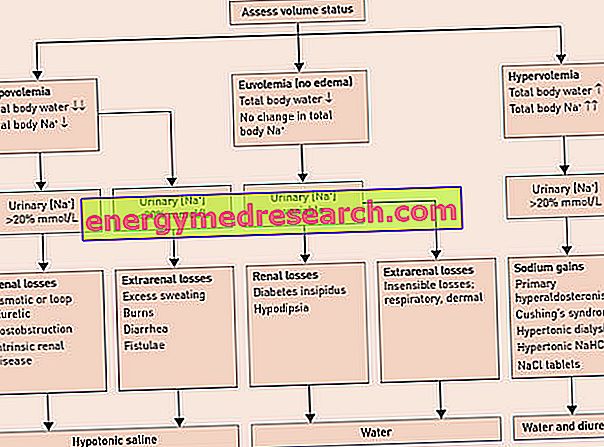Generality
Azoospermia consists of the absence of spermatozoa in the male ejaculate . This anomaly, which is one of the most serious causes of infertility, can be caused by:
- Obstruction of the seminal tract that, starting from the testicle, leads the spermatozoa to the outside (obstructive azoospermia).
- Testicular production deficiency (secretory or non-obstructive azoospermia).

If the patient wishes to procreate, the spermatozoa recovered from the testicle by bioptic needle or surgical removal, can be microinjected into the female egg, as part of a medically assisted procreation treatment.
What's this
Azoospermia is an abnormality of the seminal fluid, characterized by the total absence of male gametic cells. This disorder has obvious consequences on fertility.
If sperm production is zero, man cannot procreate, except for the use of medically assisted procreation techniques.
The percentage of infertile subjects with a picture of azoospermia settles at around 10-15%.
The male reproductive system is a complex system, consisting of internal organs (prostate, seminal vesicles and proximal urethra) and external (penis and distal urethra, scrotum and testicles).
The whole system works under the control of androgenic hormones, in particular testosterone, with the supervision of the pituitary and the adrenergic and cholinergic nerve networks. The balance between hormones and nerve signals is fundamental, so that everything works correctly.
Types of azoospemia
Azoospermia can be divided into two categories: obstructive or secretory.
OSTRUCTIVE OR EXCRETORY AZOOSPERMIA
In obstructive azoospermia, the seminal tract is missing or blocked.
While sperm production in the testicles (spermatogenesis) is normal, the real problem lies in the "passage" of the same male gametes from the testicle to the outlet of the prostate ducts.
The obstruction of the seminal tract can occur at the level of the epididymis or the vas deferens and ejaculators. This dysfunction can be:
- Congenital, ie present at birth;
- Acquired, secondary to trauma, scarring of infectious diseases or surgical interventions with voluntary or accidental ligation of the vas deferens.
The obstruction of the seminal tract is generally associated with a normal testicular volume and a hormonal picture (FSH, LH and testosterone) within the limits of normality.
NON-OSTRUCTIVE OR SECRETIVE AZOOSPERMIA
Secretory azoospermia consists of the lack of sperm production by the testicle, in the absence of an obstruction of the seminal tract. Only in some cases, in the testicular tissue of the subjects affected by the disorder, it is possible to find some isolated foci of spermatogenesis.
Also secretive azoospermia can derive from congenital causes (cryptorchidism, Klinefelter's syndrome, aberrations and / or deletions of the Y chromosome), iatrogenic (chemotherapeutic), hormonal (hypogonadotropic hypogonadism), traumatic and / or neoplastic.
These cases are generally characterized by small testicles and altered hormonal dosages.
Causes
The azoospermia can be caused by numerous factors, which act directly on the testicle damaging the seminal cells or altering the maturation processes.
Azoospermia can be due to pathological processes that affect the structures through which the seminal fluid is conveyed to the outside (epididymis, vas deferens, etc.) and such as to cause obstruction or blockage.
These conditions include:
- Congenital malformations;
- Inflammations (epididymitis, prostatitis, etc.);
- Infectious processes (mumps contracted after the age of development, genital tuberculosis, gonorrhea, etc.);
- Voluntary surgical interruption (for contraceptive purposes) or complication of other procedures (eg correction of inguinal hernia).
Azoospermia may also depend on sclerosis or testicular atrophy due to:
- Cryptorchidism (testicles retained in the inguinal canal);
- Orchitis (testicle inflammation);
- Varicocele (harmless swelling caused by the growth of varicose veins);
- Trauma;
- Exposure to high temperatures for long periods (heat) and to various toxic substances.
The inadequate quantity of spermatozoa can also be a consequence of the intake of cytotoxic drugs (eg chemotherapy for the treatment of neoplasms), hormonal therapies and radiotherapy.
Alterations in spermatogenesis can also be caused by disorders of the endocrine system, such as:
- Imbalances of the hormonal order (hypothalamic-pituitary-gonadal axis);
- Adrenal pathologies;
- hyperprolactinemia;
- Hypogonadism;
- Hypothyroidism.
Some congenital malformative anomalies, on the other hand, involve the complete absence of germ cells in the testicle, as in the case of:
- Klinefelter syndrome;
- Microdeletions of parts of the Y chromosome;
- Disorders of sexual differentiation.
Symptoms, signs and complications
The azoospermia symptomatology depends on the triggering causes.
In any case, this dysfunction compromises the subject's fertility. This does not mean that we cannot categorically have children, as some patients with azoospermia may try to resort to medically assisted procreation techniques.
Diagnosis
From the clinical point of view, azoospermia is defined as the absence of spermatozoa in the ejaculate, documented on two sperm samples subjected to centrifugation (spermiogram).
The assessment of the causes provides a diagnostic path that includes medical history, physical examination, laboratory investigations and instrumental diagnostics.
Anamnesis and physical examination
The investigations to ascertain the causes of azoospermia begin with a general medical history of the man, that is with the collection of important data for the medical specialist.
In particular, information regarding:
- General characteristics: age, ethnicity, height and weight;
- Frequency of sexual intercourse;
- Lifestyle (for example, if you smoke or habitually consume alcohol);
- Primary infertility (if the man has never managed to induce a pregnancy);
- Secondary infertility (if in the past the man has already induced a pregnancy in the current partner or in a previous relationship).
The anamnesis concludes with the search for possible:
- Diseases of the urogenital system: eg cryptorchidism, testicular trauma, orchitis, epididymitis, prostatitis and varicocele;
- Sexually transmitted diseases;
- Previous surgical interventions in the genital tract;
- Chemotherapy or radiotherapy for oncological diseases;
- Use of some drugs.
The doctor will also have to evaluate the patient's family history (eg cases of infertility, abortions, genetic, metabolic and endocrinological pathologies, etc.).
After the anamnesis, the doctor carries out an objective examination of the urogenital apparatus :
- In the obstructive forms of azoospermia, the testicle presents and continues to produce spermatozoa; at visit, testicles of good volume, with often dilated epididymis, are characteristically found.
- On the other hand, secretory azoospermia is associated with testicles of low volume.
Laboratory tests and instrumental diagnostics
Depending on the causes of azoospermia suspected, the specialist doctor will decide to proceed with a series of laboratory tests and with the appropriate instrumental diagnostic tests.
These in-depth investigations allow the definition of the correct diagnosis and can include:
- Hormonal and microbiological tests;
- Search for anti-sperm antibodies;
- Ultrasound of the prostate and seminal vesicles.
If necessary, the doctor can also subject the patient to testicular biopsy, cyto-aspiration with fine needle, genetic analysis and sperm function test.
In obstructive azoospermia, the values of hormones that stimulate testicular activity (FSH for sperm production and LH for male sex hormone production) are normal. In secretory forms, on the other hand, the hormonal picture is altered, typically with elevated FSH values and it is not uncommon to find stones inside the testicle on ultrasound examination.
Examination of seminal fluid (spermiogram)
The spermiogram is the exam that evaluates the state of health of the ejaculate and spermatozoa, both at a macroscopic and a microscopic level.
With the examination of the seminal fluid, in particular, it is evaluated:
- Volume;
- Appearance;
- Fluidification and viscosity;
- pH;
- Concentration;
- Motility;
- Morphology;
- Areas of agglutination (that is, of aggregation, which must be absent: the presence is generally an index of infections or the presence of autoantibodies);
- Presence of immune cells (leukocytes);
- Degree of maturation, number and motility of spermatozoa.
In general, at least two exams are required three months apart.
Possible outcomes of the spermiogram | |
normozoospermia | The ejaculate is normal, as are the parameters related to sperm concentration, motility and morphology |
Normocinesi | Normal percentage of motility and quality of spermatozoa movement |
Oligospermia or dyspermia | Sperm concentration and overall quality are lower than the reference values |
Oligoposia | Low amount of ejaculate |
oligozoospermia | Sperm concentration reduction |
cryptozoospermia | Presence of very rare sperm in the ejaculate |
aspermia | Absence of ejaculate |
Azoospermia | Total absence of spermatozoa in the ejaculate |
Dyskinesia | Qualitative alteration of sperm motility |
asthenozoospermia | Reduced percentage of motile spermatozoa |
Akinesi (or akinesia) | Complete absence of mobile spermatozoa |
teratozoospermia | Increased percentage of atypical and abnormal spermatozoa |
Histological diagnosis
To establish the differential diagnosis between obstructive and secretory azoospermia, it is necessary to perform a bilateral testicular tissue collection.
The recovery of sperm from the testicle can be performed according to different surgical techniques:
- TESE (Testicular Sperm Extraction) : surgical extraction of testicular tissue;
- TESA (Testicular Sperm Aspiration) : percutaneous aspiration of seminiferous tubules with thin needle;
- PESA (Percutaneous Epididymal Sperm Aspiration) : percutaneous aspiration of spermatozoa from the epididymis, with a fine needle;
- MESA (Microsurgical Epididymal Sperm Aspiration) : sperm aspiration from the epididymis through a surgical incision.
It should be noted that the possibility of withdrawing sperm from the testicle varies according to the type of diagnosis: in patients with obstructive azoospermia spermatozoa are collected in almost 100% of cases, while in those affected by the secretory form the average of recoveries is variable.
Therapy
Non-obstructive azoospermia
In the case of obstruction of the vas deferens or epididymis, the azoospermia therapy aims at definitive microsurgical correction of the stenosis, where possible. The intervention consists in the recanalization of the seminal ways, through the realization of a new way of communication.
If, despite the treatment, the appearance of spermatozoa is not obtained in the ejaculate and the patient wishes to conceive a child, it is possible to attempt the recovery of the gametes directly from the testicle or from the epididymis for a medically assisted procreation procedure. The material thus collected, after appropriate evaluation and preparation in biological media, will be cryopreserved in liquid nitrogen.
Secretory azoospermia
Men with secretory azoospermia who are motivated to have a child can be tested for sperm in the testicular parenchyma. The successfully recovered seminal cells can then be used for the ICSI assisted reproduction technique (intracytoplasmic sperm injection).



